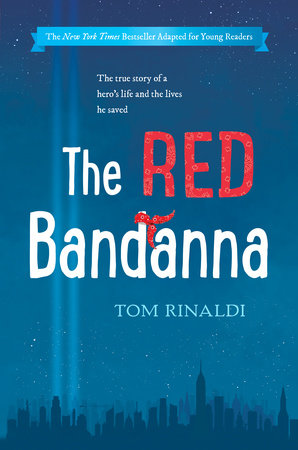Showing the Next Generation the Heroism and Courage of 9/11 Through Story
by the Brightly Editors
Last year, ESPN national correspondent Tom Rinaldi released The Red Bandanna, a stunning, heartbreaking, and inspiring biography of a young man named Welles Crowther. Welles had always wanted to be a firefighter and was planning to leave his job on Wall Street to pursue his dream when the Twin Towers were attacked on September 11, 2001. Welles disappeared that day, seemingly without a trace — until, eight months later, his family learned that several survivors recalled being led out of the South Tower on 9/11 by a man wearing a red bandanna. Welles’s mother immediately knew the man who saved them was her son. Welles was, after all, a firefighter at heart, willing to sacrifice his life for others — and Welles had carried a red bandanna everywhere with him since childhood.
The Red Bandanna is now available as an adapted new edition for middle grade readers. We chatted with Tom Rinaldi about why Welles’s story is important for kids to discover today, what teachers are saying about the book, and how the red bandanna has become a symbol of strength, courage, and heroism for people of all ages.
What inspired you to create a Young Readers’ Edition of The Red Bandanna? Can you talk a little bit about what it was like to craft this version of the story?
It’s difficult to believe it has been 16 years since 9/11. For many of us as parents, it’s a day we lived through that will never fade. But nearly a generation has passed since the attacks. The day is not something middle school children lived through; it is an event to learn about and study, in all its power.
In adapting the original book into a version for middle school readers, we wanted to tell the story of 9/11 through the lens of a single life, a life with lessons that might help shape character, and deepen their understanding of an event that will forever be part of our nation’s story.
The Red Bandanna has made its way to many classrooms. Have you heard from teachers who’ve taught the book in their class? What have they shared about the experience?
I’m so grateful the book has been embraced in schools, and at a range of grade levels, from middle schools through colleges.
Some of the most meaningful feedback has been from teachers, in sharing their students’ reactions to Welles’s story. Many reached out, to say their classes had never connected with the towers falling, before learning about Welles and his sacrifice.
Students have found the journey of someone, in many ways, just like them — not the class valedictorian, or the all-state star, but a boy who grew up with a sense of service to others, and who never gave up on his first dream to become a firefighter.
For readers who haven’t yet read the book, how did you come to tell this story?
I was first part of telling Welles’s story as a television feature on ESPN, on the 10th anniversary of the attacks. The response to our story was deeply moving.
The producer of that story, my friend Drew Gallagher, was a college classmate of Welles. He first introduced me to the story.
Why do you think it’s important for young people to read about and think about heroism and courage?
Those words can seem bigger than life, belonging to lives distant and separate from our own.
Welles’s life has many lessons, and shows how he reached his final hour and the decision he made to save others, years before the day he died.
Heroism and courage may seem like sudden acts. In fact, they find their shape in the lives we lead every day.
The audience for this new edition is tweens, who, as you noted, weren’t alive when 9/11 happened. For them, it’s not the lived event that it is for their parents. How do you think stories like this one help them understand this piece of history?
When we introduce the topic of 9/11 in schools, what are the words and images we first present to our children? For many, it’s the falling facades of the twin towers, becoming memories of air as they disappear from the city skyline. Those images, even for us who witnessed them, can still seem unreal.
Welles’s story is smaller in scale, but epic in its meaning and sacrifice. It’s a story tweens can grasp, and contemplate, on human and accessible terms.
The symbolism of the red bandanna has transcended the single day of September 11. Red bandannas now symbolize something special. What do they mean to you?
I carry a red bandanna in my pocket nearly every day, and have since first learning of Welles’s story.
It’s a tangible reminder, a new red badge of courage. In carrying and touching it, I’m reminded to think of others, and to take pride in our collective strength, each day, in all the uncertainties we face in the world today.

